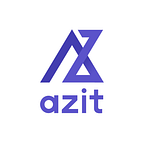Blockchains have layers? Layer 2.0 Explaned
‘azit’ is a blockchain-based, point integration platform for real estate and residential services. ‘azit’ provides a service that allows users to conveniently use points as they see fit for residential services related to real estate or community facilities by integrating points that can be used anywhere.
Welcome to ‘azit’!
Today we would like to talk about what Layer 2.0 is. Layer 2.0 has been uprising ever since Ethereum’s high gas fees, network freezing, low transaction ability etc.
So, what is Layer 2.0?
Layer literally means that there are many stages in the blockchain.
Layer 1.0
- Blockchain Network (e.g., Ethereum, Bitcoin, Solana etc.)
Layer 2.0
- Upgraded blockchain technology to solve blockchain’s problem
- Speed
changed transactions within the Layer 1.0 to offchain (Layer 2.0)
Increased TPS through consistency verification through a separate agreement method
Scalability :
Entered as moderator after standardizing asset records between Layer 1
Expanded blockchain services by communicating between Layer 1 via
Background
At first, scalability was not a big concern for the Ethereum ecosystem. Because there was not much traffic on the Ethereum network before ERC-20, ERC-721 Tokens were used. And then, when many DeFi, NFT services appeared, transaction volume emerged to another level, raising gas fees and network issues.
Let’s look into some more examples where Layer 1.0 hit the wall
- CryptoKitties
The infamous CryptoKitties, ERC-721 Token based DApp, launched in Nov. 2017
The love for CryptoKitties exploded, resulting enormous traffic to Ethereum network. This created delays for the service, users couldn’t trade or breed the NFTs and gas fees went straight up.
- DeFi
Ethereum network experienced a serious congestion when DeFi, which involves in huge transactions, meta appeared.
Competition between DeFi users to get a faster transaction got worse.
Resulting in cases which sometimes gas fees rose to 100$
Which all became a burden for the users
Rollup
- Optimistic Rollup
Based on Fraud Proof
Optimistic Rollup is parallel to Ethereum’s layer 2.0 main chain
Can execute smart contract of the right size along with keeping security with Ethereum
It can be easily built and be compatible with EVM
But the speed is not so much reliable compared to other layer 2.0 solutions (Plasma, ZK Rollup etc.)
- ZK Rollup
ZK Rollup is based on validation, zero knowledge proof to be more exact
Proving that ‘this can only be from layer 2.0’ by using complex equations and cryptic structures
ZK Rollup needs only validation rather than all the transaction data
The difference between Optimistic Rollup is that there are no limits to security-guaranteed asset among the chain and the asset transfer speed is much faster
So, it is more fit for payment
ZK Rollup has the overall advantages compared to Optimistic Rollup, but the technology itself is quite complex and it is not easy to build due to early stage of the concept
Sidechains
- Side chains are blockchains connected with Layer 1.0 (Ethereum) and 2WP (2-way peg)
- Based on using individual blockchain that works independently on the same level of Ethereum main chain
- Sidechains can be vulnerable due to having individual consensus algorithm, block creating rule, verifier nodes
- Some doesn’t define sidechains as Layer 2.0 solution, but sidechains can be compatible to EVM and can be designed in various ways
Validium
- Based on Validity Proof just like ZK Rollup, but doesn’t record the transactions on the main chain
- Scalability is Validium’s top game
- ZK Rollup’s max TPS is 2,000 ~ 3,000, while Validium can go up to 9,000 TPS
- Validium doesn’t use Ethereum’s security, which makes it more vulnerable in security and less decentralized than ZK Rollup
StateChannel
- Based on using individual blockchain that works independently on the same level of Ethereum main chain
- Since it’s an independent blockchain, it can use agreement algorithms like PoA (Proof of Authority), DPoS (Delegated Proof of Stake) etc. regardless of Ethereum
- StateChannel is very effective on long term onchain asset trading, but has a weak spot because you can’t trade with anyone that is outside the channel and need to stake a massive amount of asset on the channel if your willing to use it as some other method rather than simple trading.
- More fit for using it on large amount of asset for complex objectives rather than repeated simple payments
Wrapping up
Ethereum has already built an unimaginable ecosystem, and is still expanding.
Layer 2.0 still seems to have many security and technical issues to be improved, but we think various Layer 2.0-related services will be newly born and disappear in the future.
